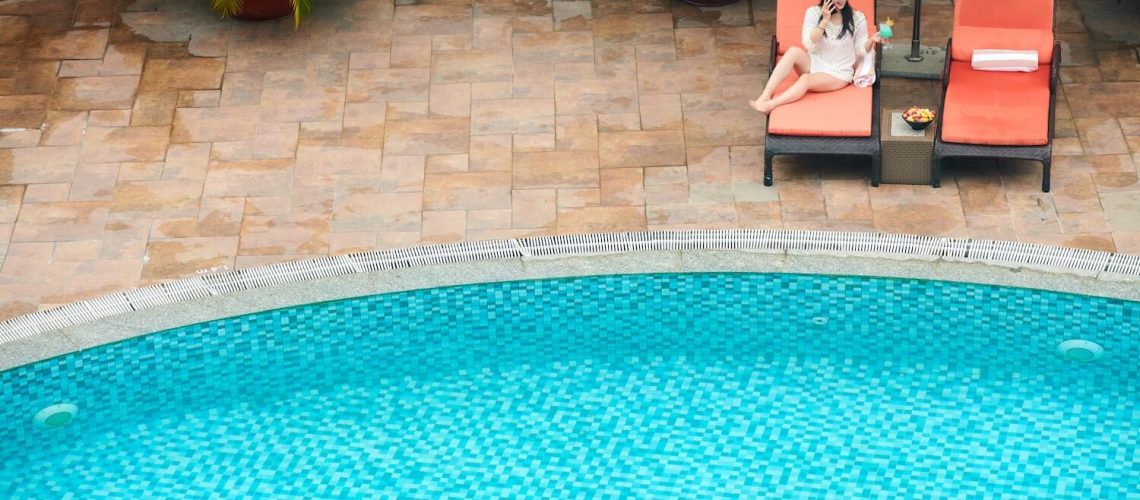Your backyard is more than just an outdoor space—it’s an extension of your home, and for many, a personal oasis. Whether you use it to entertain guests, enjoy family time, or simply relax by the pool, a well-designed backyard can significantly enhance your lifestyle. One of the key elements in creating a visually stunning and functional outdoor area is the use of pavers. From pool decks to patios, pavers offer the versatility and aesthetic appeal necessary to craft a seamless, unified look that ties your entire backyard together.
In this article, we’ll explore how you can create a cohesive design that transitions smoothly from pool to patio using unique paver designs. We’ll discuss everything from selecting the right materials and color schemes to innovative design ideas and functional features. By the end, you’ll have all the tools and inspiration you need to transform your outdoor space into a unified, visually appealing retreat.
Why Choose Pavers for Your Pool and Patio?
Before we dive into the design elements, let’s first look at why pavers are an excellent choice for pool decks and patios.
Paver Durability and Longevity
One of the primary reasons homeowners choose pavers is their durability. Pavers, whether made from concrete, natural stone, or brick, are built to last. They can withstand heavy foot traffic, weather conditions, and the wear and tear that comes with being in a high-use outdoor space. Unlike poured concrete or wood decks, pavers don’t crack easily, and if one does get damaged, it’s a simple matter of replacing that individual piece rather than having to redo the entire surface.
Designing Safety First
Safety is a top concern for pool areas, especially if children or elderly family members are regular visitors. Many paver materials are naturally slip-resistant, providing better traction than smooth concrete or tile. Textured pavers, especially those made from materials like travertine or certain types of concrete, offer excellent slip resistance even when wet, making them an ideal choice for pool decks where safety is paramount.
Low Maintenance Ideas
Pavers are incredibly low-maintenance compared to other outdoor surface materials. They resist stains, are easy to clean, and don’t require frequent sealing or repairs. In the rare event that a paver does need to be replaced, it’s a quick and straightforward process, as you don’t have to disrupt the entire area.
Unique Design Flexibility
Perhaps the greatest appeal of pavers is their versatility. Available in a wide range of colors, shapes, sizes, and textures, pavers allow you to create virtually any design you can imagine. Whether you prefer a sleek, modern look or a more rustic, natural aesthetic, there’s a paver design that will suit your vision. Moreover, pavers can be arranged in intricate patterns or kept simple for a more minimalist approach. This flexibility makes them the perfect choice for creating a unified look between your pool and patio.
Planning a Unified Pool-to-Patio Transition
The key to creating a unified look between your pool and patio is thoughtful design. When done right, the transition between these two spaces should feel seamless and cohesive, rather than disjointed or mismatched. Here are some critical design strategies to consider as you begin planning your project.
1. Selecting the Right Materials for Cohesion
The material you choose for your pavers will set the tone for your entire backyard design. While it’s not necessary to use the same material for both your pool deck and patio, choosing complementary materials ensures that the two areas flow naturally into one another.
Travertine Pavers
Travertine is one of the most popular materials for pool decks, and for good reason. This natural stone not only has a sophisticated, timeless appearance, but it also stays cool to the touch even on hot days, making it perfect for poolside lounging. Its non-slip surface adds an extra layer of safety, and its range of earthy tones—such as creams, browns, and grays—can complement any outdoor aesthetic. When using travertine for both the pool and patio, you ensure a cohesive, harmonious look that blends with the natural landscape.
Concrete Pavers
Concrete pavers offer endless possibilities for customization. They come in a wide variety of colors and finishes, and can even be made to mimic other materials like brick or stone. Concrete pavers are durable and budget-friendly, making them a practical choice for both pool decks and patios. By choosing complementary colors and textures for the two areas, you can create a seamless connection between the pool and patio without breaking the bank.
Natural Stone
Natural stone pavers, such as sandstone, slate, or limestone, lend a luxurious and organic feel to outdoor spaces. These materials often feature irregular shapes and textures, which give them a more natural, free-flowing look. By using the same stone (or a similar stone in complementary hues) for both your pool and patio, you can create a visually striking and cohesive design.
2. Establishing a Consistent Color Palette
Color plays an essential role in unifying your pool and patio. While you don’t need to stick to one color, maintaining a consistent palette helps create visual harmony between the two spaces. Here are some tips for choosing a color scheme that ties everything together:
Neutral Tones for Timeless Appeal
Neutral tones—such as beige, cream, gray, and soft browns—are incredibly versatile and work well in almost any setting. These colors have a natural, understated elegance that blends seamlessly with the surrounding environment. By choosing similar neutral tones for both the pool deck and patio, you can create a calm, soothing outdoor retreat.
Complementary Contrasts
If you prefer a more dynamic look, you can use contrasting colors in the pool and patio areas, as long as they complement each other. For example, a light-colored travertine pool deck paired with dark slate pavers on the patio can create a striking visual contrast while still maintaining harmony. The key is to ensure that the tones, though different, work well together in the overall design.
Warm vs. Cool Tones
Another approach is to play with warm and cool tones. Warm colors like terracotta, beige, and sandy browns bring a welcoming, earthy feel to the space, while cool tones like gray, blue, and charcoal create a sleek, modern look. Pairing these tones thoughtfully can create a balanced, visually pleasing outdoor space.
3. Creating a Seamless Design Flow with Patterns and Borders
Patterns and borders play a significant role in guiding the eye and connecting different areas of your outdoor space. While the pool and patio may serve different functions, consistent design elements can help them feel like part of the same cohesive space.
Mimicking Patterns
You can also create cohesion by repeating certain paver patterns in both the pool deck and patio areas. For instance, if you use a herringbone pattern on the patio, consider incorporating that same pattern into the pool deck’s design, perhaps as an accent or border. Similarly, repeating a geometric design or circular pattern in both spaces will create a sense of unity without being overly repetitive.
Mixing Patterns for Depth
On the other hand, if you prefer a more eclectic look, mixing patterns can still create cohesion if done thoughtfully. For example, you could use a more intricate, detailed pattern around the pool area and a simpler, more understated pattern for the patio. The key is to use complementary colors and materials, so the different patterns don’t clash but rather add depth and interest to the design.
Unique Paver Design Ideas for a Unified Pool-to-Patio Space
Now that you have the basics of material selection, color palette, and layout, it’s time to think creatively about design. The following paver design ideas will help you craft a space that not only looks cohesive but also stands out for its beauty and functionality.
1. Geometric Patterns for a Modern Aesthetic
Geometric patterns are an excellent way to add a modern, structured look to your outdoor space. Whether you opt for squares, rectangles, or hexagonal shapes, geometric designs offer a clean, polished appearance that can seamlessly transition from pool deck to patio.
For a truly unified look, consider continuing a geometric pattern from the pool deck onto the patio, perhaps changing the scale or direction of the pattern to differentiate the spaces slightly while maintaining visual continuity. You could also play with the size of the pavers, using larger ones for the patio and smaller ones around the pool, to add visual interest while keeping the design cohesive.
2. Organic Curves for a Natural Flow
If you’re aiming for a more organic, natural look, consider incorporating curves and free-flowing shapes into your paver design. Curved paver pathways, soft circular shapes, and meandering lines can create a sense of fluidity and movement, especially in a garden-like backyard setting.
Curves work particularly well with natural stone pavers, whose irregular shapes and textures mimic the look of rocks found in nature. By using curved designs around both the pool and patio, you can create a sense of unity while maintaining a relaxed, informal atmosphere.
3. Mixing Design Materials for Visual Texture
Another way to create a unified yet visually interesting outdoor space is to mix different materials in your paver design. For example, you could use sleek concrete pavers on your patio and natural stone pavers around the pool. The contrast between the materials adds texture and depth to the design while still maintaining a cohesive look.
Mixing materials also allows you to highlight different areas of your backyard. For instance, using one material for the main walking areas and another for seating or dining spaces helps delineate the different functional zones while keeping the overall design consistent.
Functionality Meets Aesthetics: Adding Practical Features
Finally, when designing your paver pool deck and patio area, don’t forget to consider the functional aspects of your space. Your outdoor area should not only look beautiful but also serve the needs of your lifestyle. Here are a few practical features that can enhance both the form and function of your space.
Built-in Seating Areas
Incorporating built-in seating into your paver design adds both functionality and visual appeal. Paver seating areas, such as benches or retaining walls, provide ample space for guests to relax and enjoy the surroundings without taking up valuable floor space. Consider using the same paver materials as your pool deck or patio to create a seamless transition between seating and flooring.
Fire Pits or Fireplaces
Fire pits and outdoor fireplaces are a popular addition to backyard spaces, providing warmth and ambiance during cooler evenings. Incorporating a fire feature into your patio design can create a natural gathering spot for family and friends. Using pavers to construct the fire pit or fireplace ensures a cohesive look that ties in with the rest of your outdoor design.
Conclusion
Designing a backyard that transitions smoothly from pool to patio requires careful planning and thoughtful design. By selecting the right paver pool deck materials, establishing a consistent color palette, and incorporating cohesive patterns and functional features, you can create a unified outdoor space that enhances both the beauty and usability of your backyard. Whether you prefer a sleek, modern aesthetic or a more natural, organic feel, pavers offer the versatility and durability to bring your vision to life.
With the right design, your pool and patio will no longer be separate entities but part of a cohesive outdoor oasis where family, friends, and guests can relax, unwind, and enjoy the beauty of your backyard for years to come.

